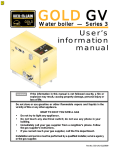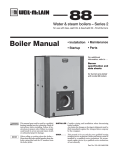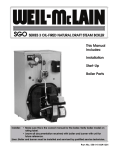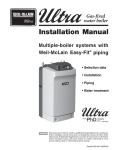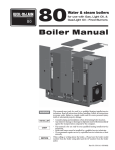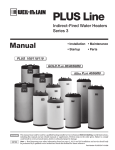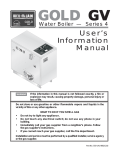Download Weil-McLain PER 550-141-396/0801 Operating instructions
Transcript
PER Series 3 Electric-Hydronic Boilers Installation Instructions Installer • • User Read all instructions before installing. Follow all instructions in proper order to prevent personal injury or death. Consider piping and installation when determining boiler location. Any claims for damage or shortage in shipment must be filed immediately against the transportation company by the consignee. • • This manual is for use only by your qualified heating installer/ service technician. We recommend regular service by a qualified service technician, at least annually. These Instructions must be used only by a qualified installer/service technician. Read these instructions completely before beginning. Failure to follow these instructions can cause severe personal injury, death or substantial property damage. When calling or writing about the boiler— Please have the boiler model number from the boiler rating label and the CP number from the boiler jacket. You may list the CP number in the space provided on the Installation and service certificate found on page 9. Part number 550-141-396/0801 PER Series 3 Electric-Hydronic Boilers Installation Instructions Please read before proceeding Hazard Definitions The following defined terms are used throughout these Instructions to bring attention to the presence of hazards of various risk levels, or to important information concerning the life of the product. Indicates presence of hazards that will cause severe personal injury, death or substantial property damage. Indicates presence of hazards that can cause severe personal injury, death or substantial property damage. Indicates presence of hazards that will or can cause minor personal injury or property damage. Indicates special instructions on installation, operation or maintenance that are important but not related to personal injury or property damage. Failure to adhere to the guidelines on this page can result in severe personal injury, death or substantial property damage. When servicing boiler — • • • To avoid electric shock, disconnect electrical supply before performing maintenance. To avoid severe burns, allow boiler to cool before performing maintenance. The boiler contains fiberglass materials. Use care when handling these materials per instructions on page 11 of this manual. Boiler operation — • • • Do not block flow of ventilation air to boiler. Will cause components to overheat. Should overheating occur, do not disconnect electrical supply to circulator. Instead, shut off the electrical supply at a location external to the appliance. Do not use this boiler if any part has been under water. Immediately call a qualified service technician to inspect the boiler and to replace any part of the control system that has been under water. Boiler water — • • • • Do not use petroleum-based cleaning or sealing compounds in boiler system. This can result in substantial property damage. Do not use "homemade cures" or "boiler patent medicines". Serious damage to boiler, personnel and/or property may result. Continual fresh makeup water will reduce boiler life. Mineral buildup in section reduces heat transfer, overheats cast iron, and causes section failure. Addition of oxygen and other gases can cause internal corrosion. Leaks in boiler or piping must be repaired at once to prevent makeup water. Do not add cold water to hot boiler. Thermal shock can cause sections to crack. Glycol — potential fire hazard — All glycol is flammable when exposed to high temperatures. If glycol is allowed to accumulate in or around the boiler or any other potential ignition source, a fire can develop. In order to prevent potential severe personal injury, death or substantial property damage from fire and/or structural damage: • Never store glycol of any kind near the boiler or any potential ignition source. • Monitor and inspect the system and boiler regularly for leakage. Repair any leaks immediately to prevent possible accumulation of glycol. • Never use automotive antifreeze or ethylene glycol in the system. Using these glycols can lead to hazardous leakage of glycol in the boiler system. 2 Part number 550-141-396/0801 PER Series 3 Electric-Hydronic Boilers Installation Instructions Pre-installation General instructions The Weil-McLain Model PER electric-hydronic boilers are assembled units designed for use in forced hot water heating systems. The suggested design temperature rise through the boiler is 20°F. The PER boiler is a complete package including the circulator and expansion tank. Low flow rates through the boiler at elevated temperatures should be avoided. The structure to be heated should be insulated in the conventional manner used in your area for electrically heated buildings. Boiler must be installed in accordance with these instructions so as not to void our warranty. Open the boiler crate and check the contents. In the event of shortage or damage, notify the transportation company immediately. Locating the boiler The compact construction of the electric-hydronic boiler permits installation in an alcove, storeroom or other small area. The location chosen should have convenient electrical service. Allow sufficient clearance above and below the boiler cabinet to permit installation of supply and return piping. A minimum of 6 inches is required at the top of the boiler for installation and accessories. A clearance of 10 inches is required on the right hand side for removal of the elements. Expansion tank sizing Undersized expansion tanks cause system water to be lost from relief valve and makeup water added through fill valve. Eventual section failure can result. If a Fill-Trol system is used, refer to Table 1 for proper sizing. If Fill-Trol action is not desired, size the expansion tank according to the water volume of the system. If a standard closed expansion tank (without a diaphragm) is used, the air vent tapping on the boiler casting makes a convenient point of connection. The No. 109 Fill-Trol is furnished as standard equipment. Table 1 Expansion tank sizing (Tank sizing based on 200 °F average system temperature.) Boiler Standard Fill-Trol tank Additional Ex-Trol tank model (for series loop or one-pipe system (for cast-iron radiators or number with convector baseboard) cast-iron baseboard) PER-15 No. 109 No. 15 PER-20 No. 109 No. 15 PER-25 No. 109 No. 15 Note: Gravity systems converted to a forced hot water system usually require additional compression tank capacity. Mounting the boiler Hydrostatic pressure test Normally, the boiler will be installed against a frame or masonry wall. If the wall surface is rough or uneven, it may be necessary to mount plywood on the wall, then mount the boiler on the plywood. Refer to “Dimensions” on page 12 and “Ratings” on page 13, and note the boiler weight. Be sure that the wall structure will support the boiler and its piping. The 9/16" top mounting holes and 5/16" lower mounting holes are on 16-inch centers to permit installation on studs in standard wall construction. The use of ¼" x 2½" lag screws is recommended for mounting the boiler. The head diameters of the top two screws must not exceed 9/16". 1. Locate the top mounting holes so that the boiler will be level. Install the screws so that the heads protrude ¾" from the wall. 2. Raise the boiler to mounting position by placing a board across the bottom of the boiler or by grasping the lower left and right inside corners. Do not attempt to lift the boiler by grasping the bottom jacket cross tie. 3. Place the top brackets over the lag screws and then install screws through the lower mounting holes. The top screws can now be tightened. Pressure test boiler before attaching piping or electrical supply. 1. Install air vent in tapping on top of boiler. 2. Plug remaining tappings, including relief valve opening. 3. Connect water supply. Fill boiler and purge all air. For more than 10 minutes, pressure-test at 1½ times maximum working pressure. Do not leave boiler unattended. Cold water fill could expand and cause excess pressure, resulting in severe personal injury, death or substantial property damage. Part number 550-141-396/0801 4. 5. 6. 7. Check for maintained gauge pressure. Visually check for leaks if gauge pressure drops. Drain boiler and repair leaks if found. Leaks must be repaired at once. Failure to do so can damage boiler, resulting in substantial property damage. Retest boiler after repairing leaks. Remove testing plugs and air vent. Do not use petroleum-based cleaning or sealing compounds in boiler system. Severe damage to boiler will result, causing substantial property damage. 3 PER Series 3 Electric-Hydronic Boilers Installation Instructions Pre-installation continued Piping the boiler Wiring the boiler After the boiler is secured to the wall, attach the supply and return piping. Refer to Table 2 for minimum pipe sizes. Install manual shut-off valves in the supply and return lines to facilitate servicing the boiler. Model PER boilers are provided with a built-in air elimination system using a float-type automatic air vent. Refer to the boiler line drawings and proceed as follows: 1. Install the pressure-temperature gauge and ¾"-¼" bushing in the 1¼" x 1¼" x ¾" tee installed on the boiler supply connection. See “Dimensions” on page 12. 2. The ¾" tapping, located to the left of the supply tapping, must be used for either an automatic venting device or piped directly to a standard closed expansion tank. 3. Install the pressure relief valve in the ¾" tapping located on the top left hand side of the boiler (see “Dimensions” on page 12). Pipe the relief valve outlet to a floor drain or near the floor. Do not pipe the relief valve to any area where freezing temperatures might be encountered. Pipe relief valve discharge line near floor close to floor drain to eliminate potential of severe burns. Do not pipe to any area where freezing could occur. Do not plug valve or place any obstruction in discharge line. 4. Connect the system supply piping to the tapping located at the right on the top of the boiler casting. 5. Connect the system return piping to the circulator flange. When solder fittings are used, be sure that the gasket is not between the flanges when the solder connection is made. 6. A Fill-Trol system is supplied with PER boilers follow the instructions attached to the valve. Electric shock hazard. Can cause severe personal injury or death if power source, including service switch on boiler, is not disconnected before installing or servicing. The Model PER electric-hydronic boilers are pre-wired for use with 240-volt, single phase, 50/60-hertz power. Refer to Figure 1 on page 13 for the reduction in boiler capacity when the line voltage is less than 240 volts. An opening is provided in the left side of the jacket top panel for the field wiring. Refer to Dimensions, page 12, and Ratings, page 13, for recommended wire sizes. All wiring must conform to the requirements of the National Electrical Code and any additional National, State or Local Code Requirements having jurisdiction. All safety circuit wiring should be N.E.C. Class 1. Do not use aluminum wire. When a PER boiler is used in a zoned system, the zone valves must be powered from an independent source, and have electrically isolated end switches or isolating relays wired in parallel to the boiler thermostat terminals. Do not attempt to power zone valves from the transformer in the boiler control system. Table 2 Pipe sizes and flow rates (Recommended minimum pipe size with 20°F temperature rise through boiler.) Boiler model number 4 Maximum flow rate GPM Minimum supply pipe size Minimum return pipe size PER-15 5.20 ¾" ¾" PER-20 6.90 1" 1" PER-25 8.60 1¼" 1¼" Control system The control system for the PER electric boiler has electronic and thermal time delays, which are employed to sequence elements on and to sequence elements off in reverse order. The contactors used in the system disconnect all current from the heating elements. The circulator control utilizes a single pole relay. Low and high limit functions are combined in a dual limit control. The control system is operated from a low voltage transformer. Part number 550-141-396/0801 PER Series 3 Electric-Hydronic Boilers Installation Instructions Sequence of operation Call for heat 1. 2. 3. 4. The thermostat contacts close, energizing the first contactor (2K), the circulator relay (1K), and the heater in the first thermal time delay (H1). Approximately 15 seconds later, the thermal delay contacts (1C) close energizing the electronic circuit inside the first electronic time delay (ED1). After approximately 2.5 minutes, the first electronic time delay energizes the second contactor (3K) and the second thermal time delay heater (H2). This sequence continues until all contactors are energized or until the call for heat ends. Call for heat satisfied 5. 6. 7. The thermostat contacts open, de-energizing the first contactor (2K), the circulator relay (1K), and the heater in the first thermal time delay (H1). After a minimum of 10 seconds, the contacts in the first thermal delay (1C) open, instantly de-energizing the electronic time delay (ED1), the second contactor (3K), and the second thermal delay heater (H2). This sequence continues until all elements are de-energized. Limit control operation 8. If the high limit setting is exceeded, the transformer secondary circuit is opened and all contactors are de-energized instantly. It is recommended that the “high” side of the control be set at 220°F. The “low” side should be set according to the design requirements of the structure to be heated but never less than 20°F below the “high” setting. The differential control should be set at a minimum of 20°F. Part number 550-141-396/0801 5 6 30 AMP 4K1 6K2 5K2 4K2 3K2 2K2 To: 6K1 5K1 EQUIPMENT GROUND Connect wire to last fused terminal 30 AMP 30 AMP 30 AMP 30 AMP 30 AMP 15 AMP 30 AMP 30 AMP 3K1 2K1 OR WIRE NUTS BK (Note 5) RD 2 1 1K 4C 3C 2C 1C H4 H3 H2 H1 3 3 3 3 B B 1 ED4 1 ED3 1 ED2 1 ED1 R R LOW LIMIT ELECTRONIC TIME DELAY RELAYS HIGH LIMIT 6K2 6K1 5K2 5K1 4K2 4K1 3K2 3K1 2K2 2K1 CONTACTORS 6K 5K 4K 3K 2K To FUSES HEATING ELEMENTS Electrical shock hazard — can cause severe injury or death. Disconnect power before installing or servicing. THERMAL TIME DELAY RELAYS TD4 TD3 TD2 TD1 CIRCULATOR RELAY 1K1 4 3 TRANSFORMER THERMOSTAT OR END SWITCH (Note 1) 1.Thermostat heat anticipator setting must be 0.45 amps. 2.All wiring must be installed in accordance with the requirements of the National Electrical Code and any applicable national, state or local code requirements. 3.All safety circuit wiring must be N.E.C. Class 1. 4.Use only copper conductors for power input wiring. Do not use aluminum conductors. 5.For 208-volt power supply, remove orange wire and replace with red wire. 6.Maximum circulator motor is 1/6 hp. (Note 6) CIRCULATOR Notes: G L2 N L1 30 AMP 30 AMP To: Schematic Wiring Diagram Items not provided 15 KW thru 25 KW 240 VAC/single phase/60 hz 2½ min. ON, 15 sec. OFF Part Number 550-224-719/0801 Weil-McLain • 500 Blaine St. • Michigan City, IN 46360-2388 A United Dominion Company LOW VOLTAGE FACTORY WIRING (Note 6) CIRCULATOR EQUIPMENT GROUND HIGH VOLTAGE FACTORY WIRING THERMAL TIME DELAY RELAYS 4C 3C 2C 1C (Note 1) THERMOSTAT 6K2 5K2 4K2 3K2 2K2 G LOW VOLTAGE FIELD WIRING ELECTRONIC TIME DELAY RELAYS ED4 ED3 ED2 ED1 TRANSFORMER F11 F10 F9 F8 F7 HEATING ELEMENTS N HIGH VOLTAGE FIELD WIRING 24 VAC 6K1 5K1 4K1 3K1 2K1 PER Series 3 Legend 6K H4 5K H3 4K H2 3K H1 R R 2K LOW LIMIT 1K HIGH LIMIT 1K1 F5 F4 F3 F2 F1 (240 VAC) B F6 L2 B L1 Ladder Wiring Diagram PER Series 3 Electric-Hydronic Boilers Installation Instructions Wiring Part number 550-141-396/0801 PER Series 3 Electric-Hydronic Boilers Installation Instructions Troubleshooting This boiler contains fiberglass materials. Use care when handling these materials per instructions on page 11 of this manual. Failure to comply could result in severe personal injury. Symptom—No heat 1. 2. 3. 4. 5. Check fuses. Power for the control circuit is supplied through the fuses for the heating element, and the circulator. If fuses are good, jumper the thermostat terminal. If boiler starts, check the thermostat and associated wiring. If thermostat and wiring are good, check the limit control. a. Jumper the “R” and “B” terminals on the “low” side of the control. If the boiler starts, replace the limit control. b. If the boiler does not start in step “a”, momentarily jumper the “R” and “B” terminals on the “high” side of the control. If the boiler starts, replace the limit control. If the limit control is good, check the transformer. a. Measure the A.C. voltage on the transformer. If the A.C. voltage is 24 volts ± 15%, the transformer is good. b. If the A.C. voltage is low, remove one secondary lead from its load connection. 1) If the A.C. voltage returns to 24V, the transformer is good. 2) If the A.C. voltage remains low, check the primary voltage. It should measure 240 or 480 volts A.C. accordingly ± 10%. If the primary voltage is correct, replace the transformer. If the transformer is good, follow the voltage path using the wiring diagram. Check each control for voltage in and out. Replace where voltage fails. Symptom—Low heat One or more contactors do not energize. Operation of any contactor, beyond the first is dependent upon the operation of three components. • Thermal time delay. • Electronic time delay; 2½ minutes. • Contactor. 1. Symptom—Boiler does not shut down One or more contactors remain on after call for heat ends. 1. Check contactors. Lower the temperature setting on “high” side of the limit control to simulate a limit operation. a. If all contactors instantly de-energize, they are good. b. If one or more contactors fail to de-energize, replace those contactors. 2. If contactors are good, check the thermal delays. Return the temperature setting on the “high” side of the limit control to its original position. Allow the boiler to sequence on with a normal call for heat. When all contactors are energized, lower the setting on the “low” side of the limit control to satisfy the call for heat. Observe the shutdown sequence and note the contactor at which it stops. Remove the wire connecting terminal 1 of the electronic delay to the thermal delay: The contactor will now de-energize, and the remaining contactors will follow in the normal off sequence. Replace the defective thermal delay. Symptom—Inoperative circulator 1. Measure the voltage at the circulator terminals with the boiler energized. If the voltage is 120V ± 10%, the control is good. If no voltage is present, replace the circulator relay (1K). Observe the sequence of operation and note at which contactor it is interrupted. If one contactor fails to energize because of an open coil, subsequent contactors will be affected (unless one has a shorted coil). To isolate the trouble, proceed as follows: a. Check contactor. Connect a jumper from terminal 3 of the electronic delay to the transformer wire going to terminal “B” on the “low” side of the limit control. b. If the contactor energizes check electronic and thermal delays. Remove the jumper from the transformer terminal and touch it to terminal 1 of the electronic delay. (The jumper now connects terminals 1 and 3 of the electronic delay). If the contactor energizes, replace the electronic time delay. If it fails to energize, replace the thermal time delay. Part number 550-141-396/0801 7 PER Series 3 Electric-Hydronic Boilers Installation Instructions Operating instructions Water treatment Do not use petroleum-based cleaning or sealing compounds in boiler system. Severe damage to boiler will result, causing substantial property damage. Eliminate all leaks. Continual fresh makeup water will reduce boiler life. Minerals can build up in section, reducing heat transfer, overheating cast iron, and causing section failure. In hard water areas or low pH conditions (below 7.0), consult local water treatment company. Boiler water pH of 7.0 to 8.5 is recommended. Freeze protection (when used) See WARNING on page 2 for important information regarding glycol hazard. Do not use automotive, ethylene glycol or undiluted antifreeze. Severe personal injury, death or substantial property damage can result. Use antifreeze especially made for hydronic systems. Inhibited propylene glycol is recommended. 50% solution provides protection to about -30°F. Local codes may require a back-flow preventer or actual disconnect from city water supply. Determine quantity according to system water content. Boiler water content is listed in the Ratings table on page 13. Remember to add in expansion tank water content. Filling the system with water Never apply power to the boiler unless the boiler is filled with water. 1. 2. 3. 4. 5. 6. 8 Close manual air vents, drain cocks, and automatic air vent, if used. Fill the boiler and system to an initial pressure of about 12 pounds per square inch. Open automatic air vent one turn, if used. Starting on the lowest floor, open air vents one at a time until water squirts out. Close vent. Repeat with remaining vents. Refill to correct pressure. Part number 550-141-396/0801 PER Series 3 Electric-Hydronic Boilers Installation Instructions Checkout procedure After filling and purging, start the boiler as follows: ❏ Turn the thermostat to its lowest setting so that there is no call for heat. ❏ Set the limit control as recommended in the Installation Instructions. ❏ Turn on the main electric switch to the boiler. ❏ Set the thermostat above actual room temperature. Check for proper sequencing of elements. Heat the entire system to about 200°F so that dissolved air and gases in the system water will be emitted and vented. ❏ Check limit control operation by lowering the control settings as described in the “Troubleshooting” section on page 7. ❏ Restore the limit control settings to their recommended values and set the thermostat to the desired room temperature. ❏ Fill in “Installation and service certificate” below. ❏ If the boiler operates incorrectly or fails to start, refer to “Troubleshooting” on page 7. Installation and service certificate Boiler model __________________ Measured Btuh input ____________ Installer ________________________ (company) Series __________ ❏ ❏ ❏ ❏ CP number ___________ Date installed _______________ Installation instructions have been followed. Checkout sequence has been performed. Above information is certified to be correct. Information received and left with owner/maintenance person. ________________________________ (address) ______________________________ (phone) _____________________________________ (installer’s signature) Part number 550-141-396/0801 9 PER Series 3 Electric-Hydronic Boilers Installation Instructions Maintenance This boiler contains fiberglass materials. Use care when handling these materials per instructions on page 11 of this manual. Failure to comply could result in severe personal injury. Draining and cleaning Checking expansion tank Do not drain the boiler during periods of shutdown unless the heating system is exposed to freezing temperatures. At the end of each heating season, open the boiler drain cock just long enough to remove any impurities or sediment that may have settled to the bottom of the boiler. Undersized expansion tanks cause system water to be lost from relief valve and makeup water added through fill valve. Eventual section failure can result. If the relief valve opens frequently, check the expansion tank. If the system has a pressurized tank with a rubber diaphragm separating the air cushion from the water (an Ex-Trol or equivalent tank), use a tire pressure gauge to check the air-charging valve on the end of the tank. If water flows, the diaphragm is ruptured or leaking. The tank must be replaced. If no water flows but the air charge has been lost, recharge the tank to 12 pounds per square inch. Periodic air loss from the expansion tank probably means a leaky charging valve. If the expansion tank is of the standard closed variety, (without a rubber diaphragm) the tank must be partly drained to re-establish an air cushion. Keeping air vent clean Loosen the cap on the Float-Type Automatic Air Vent two turns while the system is being filled with water. Should dirt or scale lodge on the valve seat causing it to leak, remove the vent cap and push the valve core in by hand to permit water to flush the valve seat clean; release the valve core quickly and replace the vent cap. For normal operation and venting, unscrew the vent cap at least two turns. Operating temperature and pressure Checking relief valve Check the relief valve once a year by manually opening the valve and allowing a small quantity of water to flow. Make sure that the valve reseats and does not leak. Replace any defective valve. 10 The maximum recommended low and high limit control settings are 200°F and 220°F, respectively. The relief valve opens at 30 pounds per square inch. The actual operating pressure will range from 12 pounds per square inch when the system is cold to as much as 15 pounds per square inch at maximum operating temperature. Part number 550-141-396/0801 PER Series 3 Electric-Hydronic Boilers Installation Instructions Handling fiberglass materials REMOVAL OF FIBERGLASS WOOL — OR — INSTALLATION OF FIBERGLASS WOOL, COMBUSTION CHAMBER LINING OR BASE PANELS: This product contains fiberglass jacket insulation and ceramic fiber materials in combustion chamber lining or base panels in gas fired products. Airborne fibers from these materials have been listed by the State of California as a possible cause of cancer through inhalation. ■ Avoid breathing dust and contact with skin and eyes. • Use NIOSH certified dust respirator (N95). This type of respirator is based on the OSHA requirements for fiberglass wool at the time this document was written. Other types of respirators may be needed depending on the job site conditions. Current NIOSH recommendations can be found on the NIOSH web site at http://www.cdc.gov/niosh/homepage.html. NIOSH approved respirators, manufacturers, and phone numbers are also listed on this web site. • Wear long-sleeved, loose fitting clothing, gloves, and eye protection. ■ Operations such as sawing, blowing, tear out, and spraying may generate airborne fiber concentration requiring additional protection. ■ Wash potentially contaminated clothes separately from other clothing. Rinse clothes washer thoroughly. NIOSH stated First Aid. ■ Eye: Irrigate immediately ■ Breathing: Fresh air. Part number 550-141-396/0801 11 PER Series 3 Electric-Hydronic Boilers Installation Instructions Dimensions 2 7/16" 6½" 7 1/16" Incoming power 1¼" conduit 2¼" 19 5/8" 31 3/16" 19 1/16" Automatic air vent 1¼" Supply Combination pressuretemperature gauge Mounting brackets (2) ¾" Relief valve 9½" ½" ½" 10" Minimum wall clearance required for element removal. 28 5/8" 8 15/16" 2 15/16" 1¼" Return 12 5" 14 5/16" 16" ½" Fill 2¼" 39603 Part number 550-141-396/0801 PER Series 3 Electric-Hydronic Boilers Installation Instructions Ratings DOE Required wire sizes and weights Boiler model number DOE heating Boiler input capacity Number of elements Element size Total amperes KW Volts phase wire Wire size 90˚C field wiring Boiler water content Approximate shipping wt. (Note 2) (Note 3) Gallons lbs. BTU/Hr KW PER-15 51,000 15 3 5 65 240/1/3 4 5.2 215 PER-20 68,000 20 4 5 86 240/1/3 3 5.2 215 PER-25 85,000 25 5 5 107 240/1/3 1 5.2 215 Notes: 1. Provide manual shutoff valves in the system piping at the supply outlet and the return inlet so the boiler can be drained without draining the entire system. 2. For other than the standard voltages shown, consult Weil-McLain Application Engineering Department. 3. Copper wire (AWG-MCM). Consult national or local electrical code manuals for runs in excess of 50 feet. Do no use aluminum wire. 4. All ratings are based on 240-volt power input. See Figure 1 for percent of boiler capacity when the input voltage is below 240 volts. Gross output ratings. Piping loss not confined to the heated area should be added to the building loss to determine total heating equipment. Percent of Rated Capacity Figure 1 39601 Boiler capacities at various voltages 100% 90% 80% 70% 60% 200 210 220 230 240 Input Voltage Part number 550-141-396/0801 13 PER Series 3 Electric-Hydronic Boilers Installation Instructions Parts This boiler contains fiberglass materials. Use care when handling these materials per instructions on page 11 of this manual. Failure to comply could result in severe personal injury. Item Description number 14 Weil-McLain part number Item Description number Weil-McLain part number 1 Control tray 428-800-000 6 Jacket element cover plate 428-800-015 2 Boiler casting with insulation 318-806-200 7 Jacket bottom panel 428-600-004 3 Jacket door 428-800-025 8 Jacket bottom cross tie 428-800-010 4 Jacket side and back panel 428-800-020 9 Element opening cover plate 590-243-200 5 Jacket top panel 428-800-005 10 Element opening gasket 1.75 diameter hole 1.50 diameter hole 590-317-523 590-317-524 Part number 550-141-396/0801 PER Series 3 Electric-Hydronic Boilers Installation Instructions Parts continued The following items are available but are not shown in the Parts drawing Description Weil-McLain part number Jacket door latch 562-850-089 Terminal block 512-050-013 Marker strip 590-850-020 Limit control 510-350-061 Circulator relay 510-350-219 Thermostat 511-950-275 Electronic delay, 2½ minutes 510-350-211 Thermal delay, 30 seconds 510-350-220 Retainer clip for thermal delay 562-650-102 Transformer 511-842-361 Line terminal and fuse block (upper) 512-050-002 Line terminal and fuse block (lower) 512-050-004 Fuses, 15A 591-850-172 Fuses, 30A 591-850-174 Relief valve (30 psig) 511-546-924 Temperature pressure gauge 510-218-099 Element contactor, 240 volt, single phase 512-150-147 Heating elements, 5KW, 240V, single phase 591-550-135 Air vent 510-148-567 Fill-Trol, 90˚ fill 510-632-086 Circulator pump 511-405-117 Universal circulator hardware kit, 1¼" 381-354-526 Drain valve 511-210-423 Part number 550-141-396/0801 15 Weil-McLain Limited Warranty for Residential & Commercial Cast Iron Boilers ◆ RESIDENTIAL WATER WARRANTY—Limited Lifetime ◆ RESIDENTIAL STEAM WARRANTY—Limited 10 Year ◆ COMMERCIAL WARRANTY—Limited 10-Year NOTE: The residential steam and water warranties do not cover residential boilers installed in buildings other than one or two family dwelling units, unless they are buildings with individual boilers for each dwelling unit. First Year-(All Residential & Commercial Cast Iron Boilers) Limited Warranty for Cast Iron Boilers: Weil-McLain warrants that its cast iron boilers are free from defects in material and workmanship for one year from the date of installation. If any parts are found to be defective in manufacture, Weil-McLain will provide replacement of such defective parts. Second Through Tenth Year-(Residential Water/Steam) Second Through Tenth Year-(Commercial Water/Steam) Limited Warranty for cast iron sections: Weil-McLain warrants that the cast iron sections of its water and steam boilers are free from defects in material and workmanship from the date of installation for the second through the tenth year. If, during such time period, any section is found to be defective, Weil-McLain will provide replacement for the original cast iron section(s). Eleventh Year and Beyond - (Residential Water Only) Limited Warranty for Cast Iron Sections: Weil-McLain warrants that the cast iron sections of its residential water boilers are free from defects in material and workmanship for the eleventh year and beyond from the date of installation.If, during such time period, any section(s) is found to be defective, Weil-McLain will provide replacement for the original cast iron section(s) upon the payment of a proportionate charge based on the time the boiler has been in service. The proportionate charge will be equal to the appropriate percentage of the list price of such section(s) at the time the warranty claim is made, and will be determined as follows: 11th year - 5%; 12th year - 10%; 13th year - 15%; 14th year - 20%; 15th year - 25%; 16th year - 30%; 17th year - 35%; 18th year - 40%; 19th year - 45%; 20th year - 50%; 21st year - 55%; 22nd year - 60%; 23rd year - 65%; 24th year - 70%; 25th year and beyond - 75%. All Residential & Commercial Cast Iron Boilers These warranties are subject to the condition that the boiler must have been installed by a heating contractor whose principal occupation is the sale and installation of plumbing, heating and/or air conditioning equipment. 16 These warranties do not cover: 1. Components that are part of the heating systems, but were not furnished by Weil-McLain as a part of the boiler. 2. The workmanship of any installer of Weil-McLain’s boilers. In addition, this warranty does not assume any liability of any nature for unsatisfactory performance caused by improper installation. 3. Any costs for labor for removal and reinstallation of the alleged defective part, transportation to Weil-McLain, if necessary, and any other materials necessary to perform the exchange. 4. Improper burner adjustments, control settings,care or maintenance. Information is included in the installation Instructions, Owner’s Information Manual and/or Startup, Service and Maintenance Instructions, and other printed technical material furnished by Weil-McLain with the boiler. 5. Boilers operated with combustion air contaminated externally by chemical vapors or with improper fuel additives, or with water conditions which may have caused unusual deposits in the cast iron sections. These warranties extend only to the first retail purchaser of the boiler and only to a boiler that has not been moved from its original installation site. THE WARRANTIES DESCRIBED ABOVE ARE IN LIEU OF ALL OTHER WARRANTIES, EXPRESS OR IMPLIED, INCLUDING BUT NOT LIMITED TO ANY IMPLIED WARRANTIES OF FITNESS FOR A PARTICULAR PURPOSE AND MERCHANTABILITY. WEILMcLAIN EXPRESSLY DISCLAIMS AND EXCLUDES ANY LIABILITY FOR CONSEQUENTIAL, INCIDENTAL, INDIRECT OR PUNITIVE DAMAGES FOR BREACH OF ANY EXPRESS OR IMPLIED WARRANTY. For prompt product warranty claims, notify the installer who, in turn, will notify the Weil-McLain distributor from whom he purchased the boiler. If this action does not result in warranty resolution, contact Weil-McLain Consumer Relations Department, 500 Blaine Street, Michigan City, Indiana 46360-2388, with details in support of the warranty claim. Alleged defective part or parts must be returned through trade channels in accordance with the Weil-McLain procedure currently in force for handling returned goods for the purpose of inspection to determine cause of failure. Weil-McLain will furnish new part(s) to an authorized Weil-McLain distributor who, in turn will furnish the new part(s) to the heating contractor who installed the boiler. If you have any questions about the coverage of this warranty, contact Weil-McLain at the address above. Part number 550-141-396/0801
















